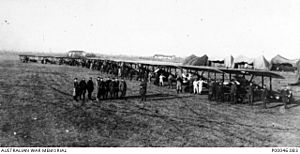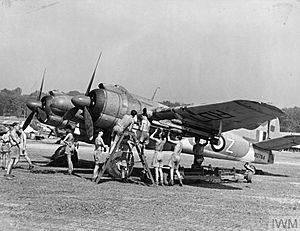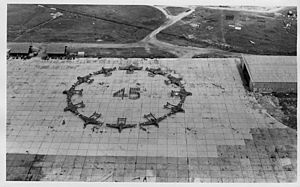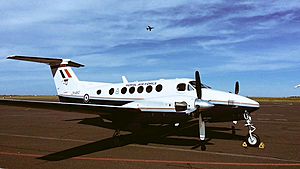No. 45 Squadron RAF facts for kids
Quick facts for kids No. 45 Squadron RAF |
|
|---|---|
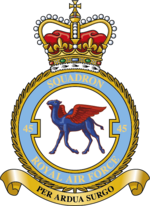
Squadron badge
|
|
| Active | 1 March 1916 – 1 April 1918 (RFC) 1 April 1918 – 31 December 1919 (RAF) 1 April 1921 – 17 January 1927 25 April 1927 – 13 January 1970 1 August 1972 – 26 July 1976 1 January 1984 – 1 April 1992 1 July 1992 – present |
| Country | |
| Branch | |
| Type | Flying squadron |
| Role | Multi-engine pilot and weapons systems operator training |
| Part of | No. 3 Flying Training School |
| Home station | RAF Cranwell |
| Nickname(s) | 'Flying Camels' |
| Motto(s) | Per ardua surgo (Latin for 'Through difficulties I arise') |
| Aircraft | Embraer Phenom T1 |
| Battle honours |
|
| Insignia | |
| Squadron badge heraldry | A winged camel, commemorating the Sopwith Camel used for a large part of the First World War, and the squadron's long association with the Middle East. Approved by King Edward VIII in October 1936. |
| Squadron roundel |  |
Number 45 Squadron is a special group of pilots and planes in the Royal Air Force (RAF). It was first formed on March 1, 1916, as part of the Royal Flying Corps. Today, the squadron teaches pilots how to fly multi-engine aircraft. They use Embraer Phenom T1 planes for training. You can find them at RAF Cranwell in Lincolnshire, working under No. 3 Flying Training School.
Contents
Squadron History
First World War Adventures
Number 45 Squadron began during World War I on March 1, 1916. They started flying Sopwith 1½ Strutter planes. These planes were not very good, and the squadron faced many challenges. Things got better in July 1917 when they switched to the Sopwith Camel.
Later in 1917, the squadron moved to the Italian front. They helped by attacking targets on the ground. They also flew patrols to find enemy planes. In September 1918, they returned to France. Many brave pilots, known as flying aces, served with the squadron during the war.
Between the World Wars
After World War I, the squadron returned to England in February 1919. It was then temporarily closed down in December 1919. But in April 1921, it started up again in Helwan, Egypt.
The squadron used Vickers Vernon planes to move troops and supplies. They also helped with mail services across the Middle East. They supported operations in Iraq and Palestine. Over time, they flew different planes like the DH9A, Fairey III, and Fairey Gordon. Around this time, they got their cool nickname, "The Flying Camels." Their squadron badge, approved in 1936, shows a winged camel. This badge reminds everyone of the Sopwith Camel plane they flew and their long history in the Middle East.
Second World War Operations
When World War II started, 45 Squadron began flying Bristol Blenheim planes. In mid-1940, they joined the North African Campaign. On June 11, they were part of the first attack on an Italian air force base. They damaged many Italian planes on the ground. The next day, they attacked ships at Tobruk.
Later in 1940, the squadron helped ground forces in the East African Campaign. They were based in Gura, Eritrea. In June 1941, they moved to Palestine. They were involved in operations in Lebanon.
From mid-1942, the squadron moved to Burma and India. Here, they fought against the Japanese forces. Three of their planes took part in the first Allied bombing raid on Bangkok.
Malayan Emergency Missions
After World War II, No. 45 Squadron served in the Malayan Emergency. They flew from RAF Station Tengah in Singapore. Their job was to attack rebel groups in the Malayan jungle. This mission, called Operation Firedog, lasted for 12 years.
The squadron also helped calm unrest in British North Borneo. At first, they flew Bristol Beaufighter planes. From 1955, they were based at RAF Butterworth in Malaya, flying de Havilland Venoms.
From the 1960s to the 1980s
In 1962, the squadron got new English Electric Canberra B.15 planes. They became involved in the Brunei Revolution and later a conflict with Indonesia. This lasted until 1966. The squadron was closed down again on January 13, 1970. This happened after the UK decided to withdraw forces from East of Suez.
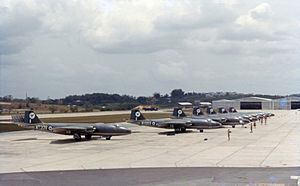
On August 1, 1972, the squadron was reformed at RAF West Raynham. They flew Hawker Hunter FGA.9s and trained pilots for ground attacks. The squadron closed again in July 1976.
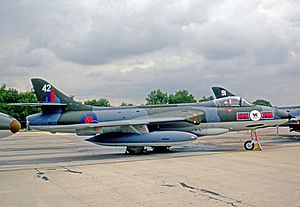
In January 1984, the squadron number was given to the Tornado training unit at RAF Honington. This unit was called No. 45 (Reserve) Squadron. It was meant to be a fully operational unit if needed. On April 1, 1992, this unit was disbanded. Its planes and people became part of No. 15 (Reserve) Squadron.
1992 to Today
On July 1, 1992, No. 45 (Reserve) Squadron was brought back. It became the Multi-Engined Training Squadron (METS) at RAF Finningley. The squadron moved to RAF Cranwell in October 1995.
In 2003, they replaced their old planes with Beechcraft B200 King Airs. These planes were maintained by Serco. In 2018, the squadron changed planes again. They now fly Embraer Phenom T1s. Today, No. 45 Squadron continues to train new pilots for the Royal Air Force.
Commanding Officers
Many different officers have led No. 45 Squadron throughout its long history. Here are some of them:
1916 to 1919
- Captain C E Ryan (1916)
- Major L A Strange (1916)
- Major W R Read (1916-1917)
- Major H P Van Ryneveld (1917)
- Major A M Vaucour (1917-1918) - sadly killed in action
- Captain R J Dawes (1918)
- Captain N C Jones (1918)
- Captain J A Crook (1918)
- Major A M Miller (1918-1919)
- Captain J W Pinder (1919)
1921 to 1970
- Squadron Leader T F Hazell (1922)
- Squadron Leader A T Harris (1922-1924)
- Squadron Leader R M Hill (1924-1925)
- Squadron Leader F J Vincent (1928-1932)
- Squadron Leader H W L Saunders (1932-1935)
- Squadron Leader A R Churchman (1935-1937)
- Squadron Leader John Walter Dallamore (1940) - killed in action
- Squadron Leader Patrick Phillip Troughton-Smith (1940)
- Squadron Leader George Oswald Leonard Dyke DFC (1944-1945)
- Squadron Leader F L Dodd (1947-1948)
- Squadron Leader E D Crew (1948-1950)
- Squadron Leader I S Stockwell (1951)
- Squadron Leader G S Cooper (1956)
- Squadron Leader J W Valentine (1960-1961)
1972 to Present
- Squadron Leader JDR Bowland (2005-2007)
- Wing Commander D Catlow (2014-2016)
- Wing Commander R Tomala (2016-2020)
- Wing Commander J Radley (2020-Present)


